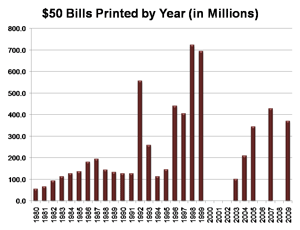Have you heard the hoopla around Congressman Patrick McHenry’s proposed legislation to replace the President Ulysses S. Grant portrait with that of President Ronald Reagan on all $50 bills printed after December 31, 2010?
It’s both interesting and sad to read all of the “us vs. them” discussions in the media and in the blogs. In other words, this is definitely not a bipartisan issue.
Take a look at some of the views as seen here: The Ronald Reagan $50 bill. Some of the links in that article go to writers with very angry viewpoints.
Interestingly, another article out of California claims there’s dissension not only across the aisle in Congress but also within the same side: Congressman wants Ronald Reagan to replace Ulysses S. Grant on the $50 bill.
Per this CNN article, earlier failed efforts proposed putting Reagan’s image on the dime, the $10 note and the $20 note.
Rather than a political issue, perhaps the recognition of our currency is more important. In response to the general question about changing the portraits on our currency, the Bureau of Engraving and Printing responded, “Changing the size or portrait figures would not improve security, but it would contribute to potential confusion for the millions of people around the world who recognize the traditional overall appearance of U.S. paper money, including the portraits that are linked to specific denominations.”
Does that mean we can never change the currency? No, but it certainly identifies a big problem with change – confusion and lack of recognition, not just domestically but around the world.
Rather than debate the Grant versus Reagan issue, let’s just review some information about the $50 bill.
President Grant’s portrait showed on the Gold Certificate of 1913 and the Federal Reserve Note of 1914. In 1929, the currency was standardized to the current size, and the $50 note consistently used only one portrait of Grant. A picture of the pre-1996 $50 with the chosen portrait of Grant can be seen here.
In the fight against counterfeiters, the $50 bills printed Series 1996 to 2001 contained additional securityfeatures. In particular, a watermark containing Grant’s portrait is included in the cotton linen blend before printing. A security thread containing “USA 50” and a small flag runs across the bill just to the right of the portrait and can be seen from both sides of the bill. Fine lines that are difficult to replicate are used in the background of the portrait and the US Capitol on the reverse. Other characteristics such as microprinting in the border and Grant’s collar, color shifting ink in the lower right “50” on the front and the large “50” on the back changed the look of the bill as well.
More security features were added and a new $50 bill entered circulation in September 2004. The watermark, security thread and color shifting ink continued in the new bill. In addition, blue and red color was added to both sides of the bill along with blue stars to the left of the portrait and red stripes to the right. In addition a single star sits just above Grant’s left shoulder. Grant’s portrait changed to flow into the bottom border and no longer has the oval border. The microprinting increased to include words in several places on the bill. The Bureau of Engraving and Printing added an interactive display of the bill on their newmoney website to help people learn the features of the new bills.
On average, the Bureau of Printing and Engraving claims the $50 bill lasts for 55 months. Plus, they note, “To stay ahead of currency counterfeiters, the U.S. will be introducing new currency designs every seven to ten years.”
Let’s look at the number of $50 bills printed since 1980. (The years are fiscal years for the Bureau of Engraving and Printing.)
That’s an interesting chart considering the goal of getting more secure bills in circulation. With a life span of 55 months (less than five years), the later years’ production numbers seem low.
Could it be that more electronic banking and funds transfer are reducing the need for the $50 bill?
But, with today’s economy, people use more cash. Perhaps more $50 bills will be needed in the near future. Or, it could be that people just do not use that many $50 bills. Perhaps the $20 and $100 bills are more popular.
Take a few minutes to browse the currencies and become familiar with the security features that can be readily seen without black lights or other devices. The Bureau of Engraving and Printing states, “Because security features are difficult for counterfeiters to reproduce well, they often do not try, hoping that cash handlers and the public will not check their money.”
If you use or accept cash, a few minutes educating yourself could prevent the loss of $50 or more.
